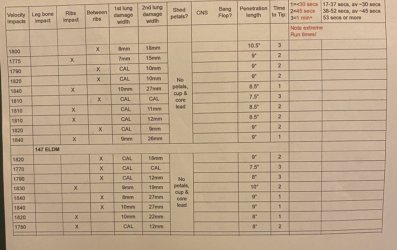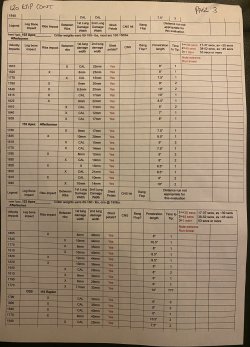I could go into a TON of detail lol. More than you probably want or are willing to read. I'll try to give you the basics of what you're asking for though. I think maybe I should start a new thread on some of this stuff though for a better discussion overall on it. Who knows when I'll have the time to do that though lol.
So in a nutshell, bullets such as Sierra TMKs, Hornady ELDMs or A-Tips, Bergers of the hybrid design, etc (for cup and core varieties), and petal-shedding mono varieties like Apex Afterburner, Hammers, Cutting Edge varieties, and McGuire Copper Rose to an extent, are actually very forgiving (or can be) to less than ideal shot placements because they do indeed come apart and they'll inflict much more damage, create much wider wounding, and cause a much faster death than other bullet designs. The softer and/or frangible bullets still tend to shed enough material outwards that they'll still hit liver and/or lung when shot placements aren't ideal and are in that "no man's land", and will typically still cause enough blood loss to find and recover the animal not far from where it was shot. However, they still won't make up for shot placements that were way off. There's only so much you can ask for here lol. So the room for error isn't massive by any means, but significant nonetheless.
Bullets that don't shed weight (or much weight), such as bonded cup and cores and mushrooming monos, and hold together for the most part as they penetrate through the animal, do tend to reduce meat loss/damage, but that comes at a trade-off. Typically, the overall amount of wounding is less with that type of bullet. If it impacts below its ideal velocity, the amount of wounding will be even less. If you miss vitals (hitting in that "no man's land"), you may very well miss recovering the animal too. A well constructed cup and core bullet or mono, that will indeed shed weight, can be much more forgiving in that particular scenario since it would produce wider wounding and may still reach vitals and be the difference between recovering the animal or not.
Another way these "well-constructed" bullets produce wider wounding overall is by the amount of hydraulic force they produce throughout their journey through the animal. The cup and cores shed weight and pieces, that reach out creating a wider wound channel, but also continue mushrooming as they continue penetrating, producing a good deal of opposing hydraulic force within the animal and that force goes outward and ruptures tissues and blood vessels. The good petal-shedding monos produce a massive amount of hydraulic force during the actual petal-shedding event. Some are better at this that others- to include some lines within the same brand of bullet. You get a lot of rupturing and trauma that occurs during that event, and it reaches out pretty far. The petals themselves tend to reach out and create secondary wounding as well. If the particular alloy of metal used in the bullet is such a way as to give some plasticity to the shank that's left, it will mushroom a bit still and still produce a decent amount of hydraulic force as well as it continues penetrating. This helps ensure it still produces disproportionate to caliber size wound channels, rather than just penciling through. Some designs struggle with this and do indeed end up penciling.
Again, I don't know how much more detail you want me to go into. I'm trying to keep this brief but answer your question still. Let me know if you want anything further to be discussed. The bottom line is that there's yet to be a bullet that allows you to put it anywhere you want on an animal and have it drop still no matter what. There are bullets though that'll still be the difference between recovering the animal and it running off maybe to not be recovered, or recovered way too late, due to being off even several inches from where intended.



